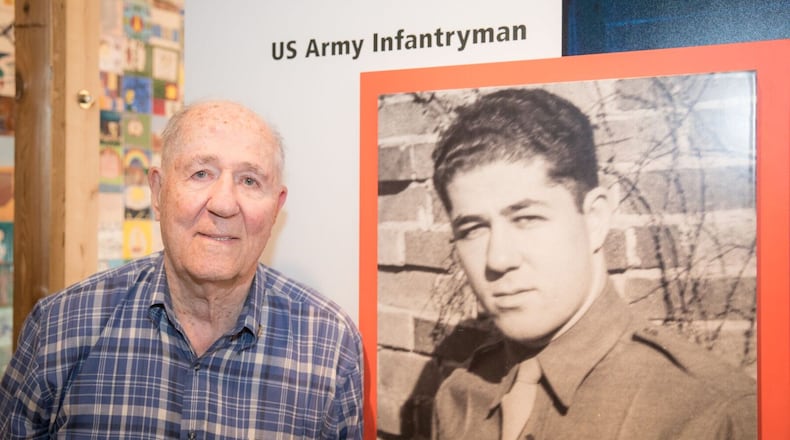It’s been 72 years since Hilbert Margol was discharged from service in World War II with his identical twin brother, Howard, beside him, but his memories of more than three years of service are as vivid as his photograph in the U.S. Holocaust Memorial Museum.
The 94-year-old Jewish veteran of the U.S. Army's 42nd Infantry "Rainbow" Division traveled from his home in Dunwoody to visit the museum in June with 10 family members, including his grandchildren. His story is featured in the first panel of the new exhibit "American Witnesses."
The exhibit highlights Americans who saw first-hand evidence of Nazi atrocities, showing their oral and written testimonies with photographs and film.
Steven Luckert, curator of the "American Witnesses" display, said that Margol was chosen to be part of the exhibit because of his "powerful and engaging" testimony of finding a death train outside the Dachau concentration camp.
“Accounts like Mr. Margol's serve as stirring reminders of the reality and horrors of the Holocaust,” he commented.
When Margol and his family visited the museum, they were glad to see his story memorialized.
“It was a great experience, I can tell you that. They treated us very warmly. It’s a great honor,” Margol said of his family’s visit to the museum.
His one disappointment, however, was that the museum did not include the photo he submitted of himself and his twin brother, who passed away last year.
RELATED: Holocaust survivor and liberator reunited
Hilbert and Howard Margol were born in 1924 in Jacksonville, Fla., and they did everything together. Both attended the University of Florida and did ROTC, and in 1942 they joined the Army Reserves—only to be called to active duty a few months later.
Even in combat, the brothers did everything they could to stay together. When they were separated during training, they sent request after request to be reunited.
According to Margol, when their commanders ignored their requests, they went straight to the top. “Our mother wrote a letter to President Roosevelt, and she got a reply saying since she was a two-star mother, her request would be granted,” Margol explained with a laugh.
Margol’s brother was transferred to the 42nd “Rainbow” Division, where they both worked as gunners on the Howitzers, a type of artillery.
As identical twins, they were mistaken for each other “all the time,” Margol said.
At first, his fellow soldiers refused to believe that Margol had an identical twin. When Howard Margol arrived at his brother’s unit fresh off the transfer, Margol was away visiting their ill mother on furlough, and “they thought it was me,” Margol said, laughing.
“They thought I was acting crazy” in order to leave the army, Margol explained. “When I got back and he told me what happened, I got a little upset because he could have just reported as me and I could have gone back home!” he joked.
After being deployed in France in 1945, Margol and his brother made their way into Germany. Their unit was part of the liberation of Dachau, a concentration camp, but what Margol most remembers is taking photographs of a boxcar outside the camp.
“We had a Brownie box camera that we had liberated somewhere along the way, but we only had one roll of film, so we were very judicious in taking pictures,” he said.
Near the gates of Dachau, Margol and his brother stumbled across a line of boxcars that were full of prisoners’ bodies, and they took photographs of the shocking sight. Howard Margol later donated these photographs to the U.S. Holocaust Memorial Museum.
“That’s why he and I were classified as liberators,” Margol said, although the official surrender happened later that afternoon when their unit was already close to Munich. In World War II, liberators were troops who helped free prisoners from concentration camps.
RELATED: Hilbert & Howard Margol: Curious twins become liberators
Before, and even after, seeing Dachau, Margol remembers not understanding the full extent of the concentration camps in Germany. “We didn’t know any details; we knew camps existed,” he said.
Although there were 32,000 people still at Dachau when he arrived, Margol said that when he went inside the camp itself, “everything was quiet.”
“We only saw maybe three or four prisoners sitting outside the barracks...not a pretty sight,” he recalled.
The Margol brothers continued their service after Germany’s surrender in May 1945, guarding Nazi officers in Salzburg, Austria. Once they were discharged on April 9, 1946, they made their way back home to Florida.
Despite a high school dream of becoming accountants, Margol and his brother started a business selling housewares house to house on credit. They came to Atlanta in 1961 to open a furniture store, first operating on the corner of Marietta Street and what is now Ivan Allen Jr. Boulevard, then as “Furniture City” at another location.
Just as they had in wartime, the two brothers stuck together, even using their identicalness as a marketing tool.
“My twin brother and I started making TV advertisements. Our theme was, ‘Mama got two for the price of one, and so can you!’” he said. Many of their advertisements appeared on Channel 17 under Ted Turner.
“Ted Turner liked our commercials because they were real hokey,” Margol joked.
Now, Margol and his family have spent 33 years living in Dunwoody. Despite the decades that have passed, Margol is always ready to share a story about his days as a soldier and the time he spent with his brother.
For Margol, his hope for remembering and memorializing World War II and the Holocaust rests with the younger generations of his family.
“I hope and pray that my offspring and the offspring of other witnesses outlive the offspring of deniers, and that’s what history is,” he said.
In other news:
About the Author
Keep Reading
The Latest
Featured





